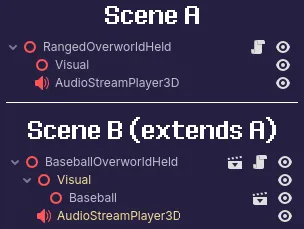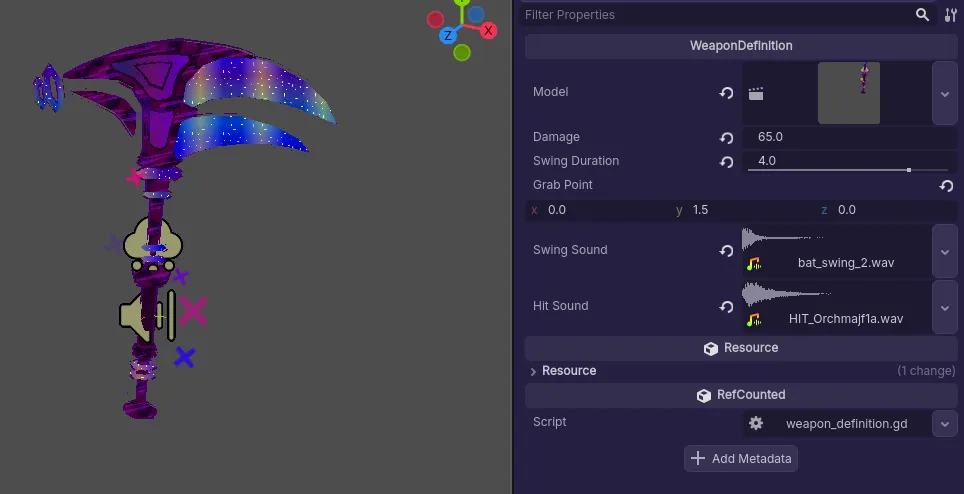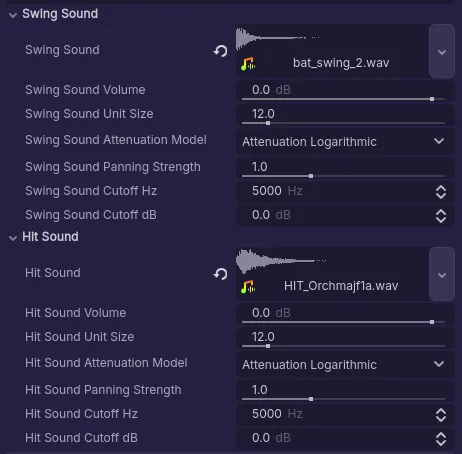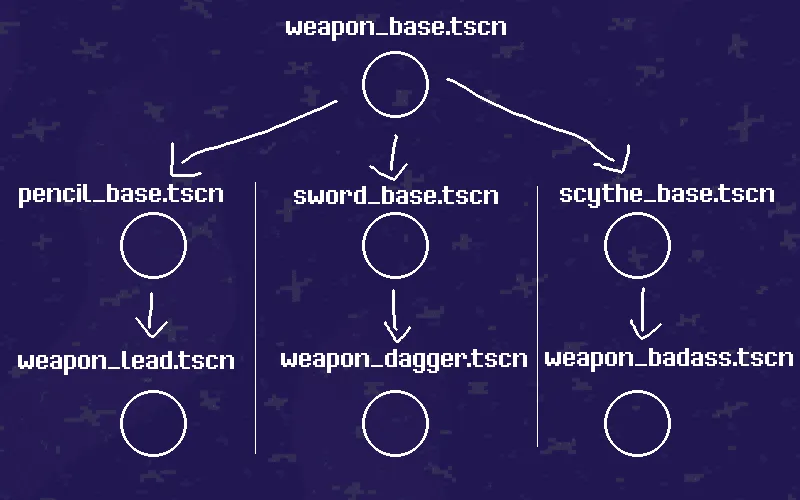One of Godot’s oddest features must be scene inheritance.
Any scene in Godot can be extended and used as the base for another scene.
 (Scene inheritance example)
(Scene inheritance example)
The nodes in yellow are carried over from scene A to B. You could think of this as creating a kind of “scene template”.
But, at the time of writing, it is Godot’s black sheep:
- They are buggy (I’ll describe why later)
- They seem redundant (GDScript already has inheritance?)
- They lack proper documentation
- They are pretty intimidating to be honest
As such, their inclusion in Godot’s feature set is odd. And, the community’s general response to scene inheritance is to avoid it!
But what could we use them for? Is there anything that they could excel at? Must we fear what we not understand?
Allow me to take you on my journey of discovering that scene inheritance can indeed be a very viable data model!
Resources
For me…
Godot development is a balancing act of data and systems.
I want to use simple data models for content, like holding an entire weapon definition in one folder (visual and behavior).
To this extent, Godot expects you to use custom Resources.
Define a custom Resource class, add whatever exports you’d like, and then they can be manipulated in the inspector.
They are very versatile! However, Resources have maintenance limitations for gameplay modelling.
To demonstrate, let’s use data to define a badass scythe.
 (Badass Scythe)
(Badass Scythe)
Yes… our scythe truly is badass.
This data model is textbook: we define the 3D model in another scene, the gameplay damage/swing duration, the point where our character holds the weapon, and the swing/hit sounds.
The root node of the player weapon scene might have a script like this for initializing itself:
class_name Weapon
extends Node3D
@onready var swing_sfx: AudioStreamPlayer3D = %SwingSFX
@onready var hit_sfx: AudioStreamPlayer3D = %HitSFX
var model: Node3D
var def: WeaponDefinition
func set_weapon(_def: WeaponDefinition):
def = _def
model = _def.model.instantiate()
add_child(model)
position = _def.grab_point
swing_sfx.stream = _def.swing_sound
hit_sfx.stream = _def.hit_sound
And this works! So here’s why it sucks:
- We have an opaque preview of the weapon’s grab point!
- If it looks off in-game, we have to opaquely modify
grab_point. - How do we test adjustments to this value? Here’s some options:
- Implement hot-reloading by making the weapon definition a
@toolscript, then useemit_changed()on the setter of thegrab_pointexport, then updateWeapon.set_weaponto listen to the changed signal ofWeaponDefinitionand update the grab point. - Edit the grab point in remote view while in-game, and copy+paste it to the weapon definition.
- Or… yknow… just restart the project every time. >15 seconds to test individual position offsets for larger projects. Do you think this is worth your time?
- Implement hot-reloading by making the weapon definition a
- If it looks off in-game, we have to opaquely modify
- We lack full control of the audio!
- AudioStreamPlayer3D has a lot of parameters.
- Your needs may change, what if you want to modify the attenuation model, volume, unit size, pitch scale, panning strength, or attenuation filter per weapon?
- The best option is to flood the definition with so many exports.
 (There are some exports missing)
(There are some exports missing)
- OH — and don’t forget to update the code!
@export_group("Swing Sound")
@export var swing_sound: AudioStream
@export_range(-80.0, 6.0, 0.1, "suffix:dB") var swing_sound_volume := 0.0
@export_range(0.1, 100.0, 0.1) var swing_sound_unit_size := 12.0
@export var swing_sound_attenuation_model := AudioStreamPlayer3D.ATTENUATION_LOGARITHMIC
@export_range(0.0, 3.0, 0.1) var swing_sound_panning_strength := 1.0
@export_range(1, 20500, 1, "suffix:Hz") var swing_sound_cutoff_hz := 5000
@export_range(-80, 0, 0.1, "suffix:dB") var swing_sound_cutoff_db := 0
@export_group("Hit Sound")
@export var hit_sound: AudioStream
@export_range(-80.0, 6.0, 0.1, "suffix:dB") var hit_sound_volume := 0.0
@export_range(0.1, 100.0, 0.1) var hit_sound_unit_size := 12.0
@export var hit_sound_attenuation_model := AudioStreamPlayer3D.ATTENUATION_LOGARITHMIC
@export_range(0.0, 3.0, 0.1) var hit_sound_panning_strength := 1.0
@export_range(1, 20500, 1, "suffix:Hz") var hit_sound_cutoff_hz := 5000
@export_range(-80, 0, 0.1, "suffix:dB") var hit_sound_cutoff_db := 0
func set_weapon(_def: WeaponDefinition):
...
swing_sfx.stream = _def.swing_sound
swing_sfx.attenuation_model = _def.swing_sound_attenuation_model
swing_sfx.volume_db = _def.swing_sound_volume
swing_sfx.unit_size = _def.swing_sound_unit_size
swing_sfx.panning_strength = _def.swing_sound_panning_strength
swing_sfx.attenuation_filter_cutoff_hz = _def.swing_sound_cutoff_hz
swing_sfx.attenuation_filter_db = _def.swing_sound_cutoff_db
hit_sfx.stream = _def.hit_sound
hit_sfx.attenuation_model = _def.hit_sound_attenuation_model
hit_sfx.volume_db = _def.hit_sound_volume
hit_sfx.unit_size = _def.hit_sound_unit_size
hit_sfx.panning_strength = _def.hit_sound_panning_strength
hit_sfx.attenuation_filter_cutoff_hz = _def.hit_sound_cutoff_hz
hit_sfx.attenuation_filter_db = _def.hit_sound_cutoff_db
THIS MAKES ME DIZZY!! Maybe we could make a custom AudioStreamPlayer3DData resource to hold these parameters instead, but we still haven’t resolved the opaque preview issue.
Let me reiterate:
Godot development is a balancing act of data and systems.
In this case, I feel as though Resources have failed us. Our data and systems are clashing, and we are forced to design through a very opaque interface. And representing something simple like audio requires a lot of boilerplate.
In general, custom Resources are suboptimal for modeling nodes. If only there was a Resource that was designed for modeling nodes…
… Hey, PackedScenes are Resources!
Scenes
Let’s not reinvent the wheel here. Let’s use a scene to model our badass scythe.
 (This represents the tricky WeaponDefinition data)
(This represents the tricky WeaponDefinition data)
Suddenly, our problems go away:
- We are no longer working with an opaque interface. We can move the GrabPoint marker to exactly where we want the weapon to be held in the 3D editor. Our system code remains responsible for positioning the weapon accordingly.
- We now have full control over the audio nodes. We no longer need to implement any audio parameter boilerplate whatsoever.
Unfortunately, this approach backslides and introduces new issues:
- We have no room to define static information, like weapon damage or item name.
- This has an easy fix: we can keep the WeaponDefinition resource around, and keep simple information there.
WeaponDefinition.modelcan now reference our new scythe scene instead. - This trick is especially useful for item names and descriptions, which we may want to reference without instantiating the scene or reading its SceneState.
- This has an easy fix: we can keep the WeaponDefinition resource around, and keep simple information there.
- When we want to create a new weapon (like Badass Scythe #2), we have no “reference” nodes. We have to add all essential nodes manually, like SwingSFX, HitSFX, and GrabPoint.
- This is maintenance hell. What if we want to add a MissSFX node? Then we have to go through all of our weapon scenes and add it. And what about hit particles? Or weapon trails? Or hitboxes?
For this scenario, Scenes are better than Resources, yet imperfect. There is a lot of maintenance involved in creating new weapons and adding features to existing ones. God will kill me for adding ambient sounds after I make Badass Scythe #37.
We are stuck making scenes with no reference nodes, and we must suffer through the maintenance hell of adding any feature late in development.
If only there was a way for us to create a “scene template” for the scythe. Then, we could work off of this template for creating a new weapon, or modify the base template to add a MissSFX node.
This is precisely what Scene Inheritance is fantastic for.
Scene Inheritance
Scene Inheritance allows us to create “base” scenes for templating pieces of content.
We can assume that all weapons will have a hit sound, a hurt sound, a grab point, etc etc. So we can define these nodes in our base weapon scene!
Then, we can extend from it later to easily setup a new weapon, or add new nodes in this base scene to quickly implement new features.
We also are given new tools at our disposal: if we create a new audio bus for weapon sounds, then we can modify AudioStreamPlayer3D.bus on the base scene, and the change is (ideally) propagated to all weapons.
Here’s a quick example for how far you could take this: what if we have different weapon categories?
 (Layers of weapon scenes)
(Layers of weapon scenes)
Our pencils, swords, and scythes may have exclusive functionality. Scythes may require special Control UI for charging, or pencils could have a rapid attack mechanism that could be modelled within the weapon scene itself.
And all of these categories can share the expectations that weapon_base.tscn declares.
If you’re still confused on when you would want to use scene inheritance, I have a golden rule for you:
If your data models themselves start to model a scene, consider using scenes or scene inheritance instead.
GOD, IF ONLY IT WORKED.
Scene Inheritance, being both undocumented and underutilized, gets no attention, and remains unstable.
From my research, it appears that one of the main appeals of scene inheritance (clean property propagation) is bugged in nested scene inheritance. See these issues for more information: #1 #2. There may be other issues I don’t know about yet either.
This sucks so bad!! On paper, scene inheritance could be a development game changer!
Still, this pattern can be utilized. There’s a few workarounds:
- When modifying the base scene of an inheritance chain, you’ll want to manually review the descendents and re-save their scenes to manually handle property propagation.
- You could also encapsulate parts of base scenes into other ones. For example, a charge bar UI for weapons could live in a separate scene. Then, editing this UI would cleanly update across all weapons.
- You could also just not use scene inheritance. Regular scenes can still be useful, and the logic of “inheritance” could be handled in GDScript instead. You lose a lot of benefits this way, but it’s still better than Resources.
I also wish that scene inheritance had more refactoring options, such as splitting a base scene out of an existing one, or mapping an existing scene onto a base scene.
Conclusion
Scene Inheritance is a strong way of developing and maintaining node heirarchies throughout the development lifecycle, making them very viable for developing content in mass.
Unfortunately, they are currently littered with issues. However, they are still not as bad as they are made out to be — under the hood, model imports can use inherited scenes, and I consider this to be one of the more stable parts of Godot.
I have also had personal success using them in my own projects, even if maintaining them is harder than they should be, due to having to manually reverify all property propagation.
Hopefully raising awareness about their functionality will help bring more attention to improving and documenting them. I believe they could become a very viable tool for a Godot developer.